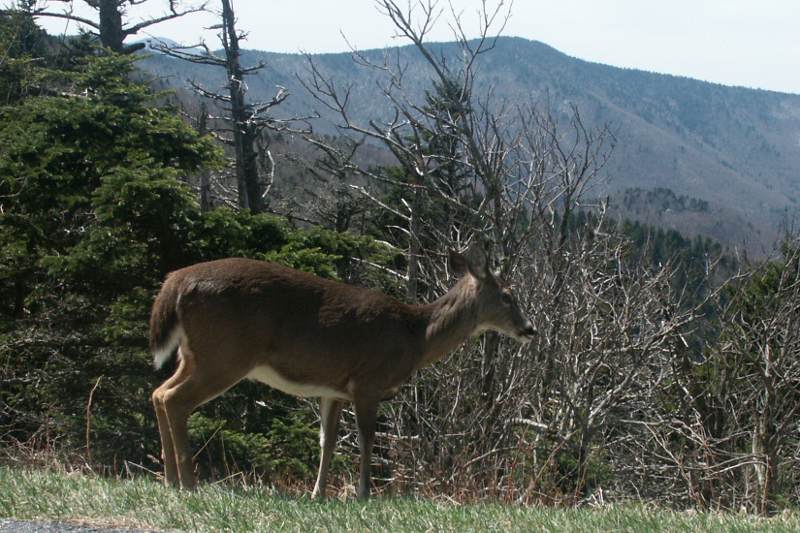From the NC Wildlife Resources Commission:
N.C. Wildlife Resources Commission biologists are observing an increasing number of hemorrhagic disease (HD) cases in white-tailed deer in the western part of the state, especially in Caldwell, Wilkes and Surry counties.
The disease has no human health implications, but is one of the most significant endemic viral and sometimes fatal diseases of white-tailed deer in the southeastern U.S.
Transported by a biting midge (or gnat), the virus enters deer through the blood stream. Common symptoms
of sick animals include emaciation, loss of motor control, fever, lameness, and swelling of the neck and head. Feverish deer often seek relief near cool bodies of water, resulting in a higher frequency of dead deer near water than on adjacent uplands. Investigations of dead deer usually reveal ulcerations on the tongue, dental pad and palate of the mouth. The mouth may also be bluish in color and the skin flush or reddish, particularly noticeable on the inside of the legs and stomach.
Commission biologists first began seeing deer afflicted with the disease in Wilkes and Surry counties. In August, reports of the disease also began coming from Caldwell, Burke, McDowell, Rutherford and Buncombe counties. The hardest hit counties are Caldwell, Surry and Wilkes.
“Most cases of hemorrhagic disease are diagnosed by biologists in the field based on examination of recently deceased deer or living deer that appear sick and have no other outward signs of injury,” said Daniel Ray, a biologist with the Commission. “Dead or dying deer infected with HD are often found near rivers, streams, lakes or ponds.
There are no human or domestic pet-related health concerns from this virus. None of us can get it.”
Hemorrhagic disease should not be confused with Chronic Wasting Disease (CWD), which is a distinctly different disease that occurs in members of the deer family. Extensive monitoring since 1999 has yielded no evidence of CWD in North Carolina and strict regulations are in place to reduce the probability of introducing this disease.
Hemorrhagic disease is a general term for two distinct viruses. The virus that causes epizootic hemorrhagic disease (EHD) is not contagious to humans, dogs, cats or other domestic pets. The virus can be contracted by other ruminants such as cows and sheep; however, it typically does not cause any symptoms in these animals and poses no risk. A similar virus called blue tongue (BT) also affects deer and it does have some minimal effects on cows and potentially greater effects on sheep.
All of the affected deer sampled in western North Carolina to date were infected with the EHD virus. None tested positive for BT virus. The threat to cattle or sheep is negligible, according to Commission biologists. Concerned livestock owners should consult with local veterinarians for more information.
HD occurs somewhere in North Carolina each year, most often in the Coastal Plain region. The last major outbreak in the state was in 2007. Other notable outbreaks occurred in 1939, 1955, 1961, 1971, 1976, 1988, 1994, 1999, 2000, 2002 and 2011. In years of severe HD outbreaks, deer mortality in some local areas was often as high as 30 percent. However, in most cases, mortality is much lower.
To report sightings of dead or dying deer, contact the Division of Wildlife Management at 919-707-0050 or wrccomments@ncwildlife.org
.
When people report sightings, they help Commission biologists pinpoint the areas of the state where outbreaks are occurring and the extent of those outbreaks. Reports of sick or freshly dead deer give biologists opportunities to collect tissue and blood samples for virus isolation by veterinarians at the Southeastern Cooperative Wildlife Disease Study in Athens, Ga. Reported occurrences are summarized annually and sent to the Southeastern Cooperative where the occurrence and outbreak extent is monitored collectively for all states.
Because the disease cannot spread to humans, hunters should not worry about dressing deer or eating venison. Deer that recover from an episode of HD develop immunity to future outbreaks.
Learn more about hemorrhagic disease .
About the N.C. Wildlife Resources Commission
Since 1947, the N.C. Wildlife Resources Commission has been dedicated to the conservation and sustainability of the state’s fish and wildlife resources through research, scientific management, wise use, and public input. The Commission is the state regulatory agency responsible for the enforcement of fishing, hunting, trapping and boating laws and provides programs and opportunities for wildlife-related educational, recreational and sporting activities. To learn more, visit www.ncwildlife.org
.



Before you comment
The comments section is here to provide a platform for civil dialogue on the issues we face together as a local community. Xpress is committed to offering this platform for all voices, but when the tone of the discussion gets nasty or strays off topic, we believe many people choose not to participate. Xpress editors are determined to moderate comments to ensure a constructive interchange is maintained. All comments judged not to be in keeping with the spirit of civil discourse will be removed and repeat violators will be banned. See here for our terms of service. Thank you for being part of this effort to promote respectful discussion.